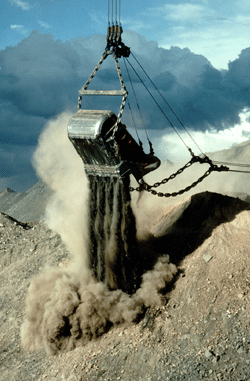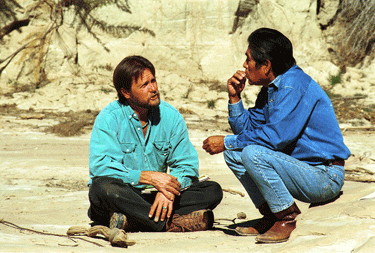Mine Closure
Air Date: Week of January 6, 2006

Mining on Black Mesa, Courtesy of Sacred Land Film Project
Members of the Hopi and Navajo nations face the loss of up to 200 jobs due to the closure of the heavily polluting Black Mesa Mine. But other community members are jubilant at the protection of the Hopi sacred springs. Host Jeff Young talks with filmmaker Christopher "Toby" McLeod who has been making documentaries on sacred Native American lands since 1978.
Transcript
YOUNG: It’s Living on Earth, I’m Jeff Young. For the first time in 35 years the Black Mesa coal mine in northeastern Arizona did not re-open after the holidays. In fact, it’s probably closed for good. The nearby Mohave Generating Station was shut down because of repeated pollution violations, and the Black Mesa mine supplied that power station’s coal.
So, for some 200 people in the Hopi and Navajo communities of Black Mesa, it means lost jobs and a rather bleak new year. For others, it means cleaner air and the preservation of places considered sacred for centuries.
Christopher "Toby" McLeod directs the Sacred Land Film Project. He's been making documentaries about native land conservation in the U.S. since 1978, when he first started working with the Hopi tribe of Black Mesa. Mr. McLeod, welcome to Living on Earth.
McLEOD: Hi, Jeff, thanks for having me.
YOUNG: You’ve been working with the Hopi for over 25 years. What did you think when you heard that the mine and power station there were shutting down?
McLEOD: All of us felt a huge sense of relief, notwithstanding the fact that there’s some suffering from the miners and the folks who are losing their employment there. But there’s been great concern for many years that Peabody Coal Company has been depleting the underground water supply, pristine, Ice Age water that emerges as springs at the Hopi villages there, and really gives the life and the name to every one of the Hopi villages. And depleting the aquifer at a rate of 1.2 billion gallons a year has been an overriding concern amongst the Hopi spiritual leaders for many, many years. So, relief, I think, and also a sense of hope, because many people working together have generated this positive outcome to clean up the air and protect the water.

Toby McLeod and Vernon Masayesva (Hopi activist, Black Mesa Trust, former Hopi Tribal Chairman) Photo by John Schaefer, courtesy of Sacred Land Film Project
YOUNG: Now, remind me, why did the coal mine need to use all this water?
McLEOD: Peabody Coal Company operated the only slurry line in the United States using water to move coal to the power plant. The power plant was 273 miles away from the mine, so they needed a huge quantity of water to run the coal, which was pulverized, through an 18-inch diameter pipe all the way to Nevada.
YOUNG: The tribal communities seem very split over this. There are those pleased with this shutdown, but there are also those losing their jobs, good paying jobs, and they’re not at all happy about that. How does this break down? Is there a clear majority opinion here?

(Courtesy of Sacred Land Project)
And ,I would say, amongst the Hopi and the Navajo there’s a deep value system that respects the Earth. And this is not to romanticize it; it’s just the way they are. The history they have in that place, their relationship to the animals and the water and everything, would lead, I think, the great majority of the people to feel very uncomfortable with a massive coal strip mine that was benefiting really very few people amongst their community.
Yes, there was economic benefit, there was a trickle-down of some of the millions of dollars that Peabody was spending in the communities, and there is individual suffering. But I think when you compare that to springs that have sustained the Hopi villages for a thousand years, you have to err on the side of caution to protect those springs. And I think most Hopi are probably quite happy that the burden is being taken off, the pressure is being taken off their water supply.
YOUNG: Do you see, is there a generational change at work here? As older members of these tribes give way to the next generation of their leaders, is there a similar understanding of the importance of these lands, commitment to preservation? Or is it being undermined – pardon the pun – by desire for commercial development?
McLEOD: There’s no doubt that the elders in Native communities are connected still to a different era. And they have the language and the songs, and they’re carrying traditions that through the 50s and 60s, with boarding schools and attempts to outlaw religion and language in Native communities, that created a real weak point throughout the 70s and 80s where the younger generation really didn’t have that cultural momentum and knowledge.
But there’s been a real renaissance in the last ten or twenty years. There’s been an attempt to revitalize the languages, to bring the elders back into the educational system so that knowledge of plants and knowledge of ceremonies, things like that, is now appreciated more, maybe, than it was ten or 15 years ago. So, I really do think there’s a cultural revitalization and that the younger people are actually listening.
That’s not to say that there aren’t casinos coming in, and that the kinds of temptations that all parents sort of struggle watching their kids do – video games, and, you know, get addicted to TV shows and things – that’s all happening out there, as well. But they have a cultural foundation. They have these places and they have this history and a sense of commitment to carry that on that I think will prevail over the long-term.
YOUNG: Filmmaker "Toby" McLeod directs the Sacred Land Film Project. Mr. McLeod, thanks for joining us.
McLEOD: Thank you.
Links
Living on Earth wants to hear from you!
Living on Earth
62 Calef Highway, Suite 212
Lee, NH 03861
Telephone: 617-287-4121
E-mail: comments@loe.org
Newsletter [Click here]
Donate to Living on Earth!
Living on Earth is an independent media program and relies entirely on contributions from listeners and institutions supporting public service. Please donate now to preserve an independent environmental voice.
NewsletterLiving on Earth offers a weekly delivery of the show's rundown to your mailbox. Sign up for our newsletter today!
 Sailors For The Sea: Be the change you want to sea.
Sailors For The Sea: Be the change you want to sea.
 The Grantham Foundation for the Protection of the Environment: Committed to protecting and improving the health of the global environment.
The Grantham Foundation for the Protection of the Environment: Committed to protecting and improving the health of the global environment.
 Contribute to Living on Earth and receive, as our gift to you, an archival print of one of Mark Seth Lender's extraordinary wildlife photographs. Follow the link to see Mark's current collection of photographs.
Contribute to Living on Earth and receive, as our gift to you, an archival print of one of Mark Seth Lender's extraordinary wildlife photographs. Follow the link to see Mark's current collection of photographs.
 Buy a signed copy of Mark Seth Lender's book Smeagull the Seagull & support Living on Earth
Buy a signed copy of Mark Seth Lender's book Smeagull the Seagull & support Living on Earth

